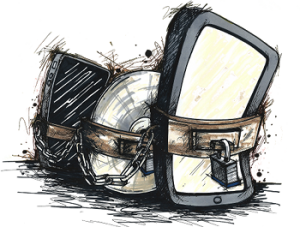About digital restrictions
Today, May 3rd 2013, is the international day against Digital Restrictions Management, powered by the Free Software Foundation. Usually, the term Digital Restrictions Management (DRM) refers to various restrictions that companies – or any other content provider – impose on digital media and data. These restrictions are there to let providers decide what you can do with your media and data and what not. By this, they keep you out of having true ownership of your data. This data is defective by design – no matter how much money you maybe paid for it. And it brings us into a world where we do not longer “buy” anything but only “license” the use of it. Restrictions like these evolve, just until one day when a licenser may legally decide to suddenly delete everything you have bought – remotely!
This year’s day against DRM focusses on a new and global threat to everything we are used to know about the World Wide Web: the World Wide Web Consortium (W3C) is discussing an Encrypted Media Extensions proposal (EME), that aims at incorporating support for DRM into HTML5. HTML is in the very heart of the Internet. Establishing DRM into HTML might become a terrific threat to the freedom of the Internet, to Free Software browsers and users freedom in general.
I hope, many people around the world join FSF and FSFE or align with other organisations in their fight against DRM in HTML5. Please, sign the petition and ring the bells as loud as you can to make other people aware of this misleading development.
Now, I would like to use this day to shed light on another issue. Something, that DRM not necessarily relates to, but, is indeed related to it: ownership of your own device.
